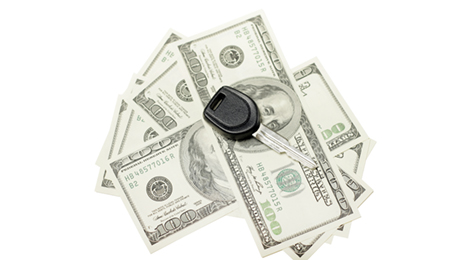Along with acknowledging the reception of additional investigative subpoenas, General Motors Financial posted across the board growth in North American loan originations during the third quarter, thanks in part to a prime financing program that rolls out fully to the parent automaker’s network of franchised dealers on Nov. 1.
Altogether, GM Financial’s North American loan originations came in at $1.957 billion during the quarter that closed on Sept. 30. The amount broke down to be a $905 million figure for the company’s AmeriCredit channel, contracts originated on vehicles sold by non-GM dealerships. The figure marked the fourth quarter in row of growth, and up from $673 million the division posted after the close of the fourth quarter of last year when the streak began.
GM Financial’s North American Q3 loan originations on new vehicles climbed to $680 million, up from $392 million in the year-ago quarter. Financing for used vehicles at GM stores also posted a healthy year-over-year, increasing from $156 million to $372 million.
“The GM channels, both new and used, increased significantly primarily because of the rollout of our prime program, which not only added incremental prime volume, but also enabled us to be more relevant to GM dealers,” GM Financial president and chief executive officer Dan Berce said.
“We now have a one-stop shopping opportunity with a full suite of products. That has increased our volumes across products, loan lease and commercial,” Berce continued.
And speaking of leasing, GM Financial’s North American lease portfolio stood at $5.8 billion at the close of the third quarter. That’s up sequentially by $1 billion. Canadian lease volume softened by $176 million quarter-over-year, but Berce said, “I want to point out that the Canadian volume, again, is going to fluctuate depending on lease offers from GM Canada. Nevertheless, year-over-year, our volume is more than double in Canada.”
In the U.S., GM Financial generated $1.417 billion in new-vehicle leases in Q3, the second quarter in a row the finance company produced more than $1 billion. Berce indicated GM Financial now handles about a third of the leasing volume for the parent automaker in the U.S.
Furthermore, more GM dealers are using the finance company’s commercial offerings. GM Financial’s total outstanding balance of commercial finance receivables stood at $7.2 billion at Sept. 30, with $2.5 billion of that amount connected with 406 North American dealers. Floorplan financing represented the largest share of the North American portfolio at 88 percent.
“As we’ve said before, now that we've got a full suite of products and as we continue to roll out prime in the U.S., we do expect to see growth here, even increase a bit, from the steady pace it’s been on,” Berce said.
Top-Line and Consumer-Credit Performance
As an entire company, GM Financial posted earnings of $158 million for the third quarter, down slightly from the $161 million the company generated a year earlier.
The company’s earnings for the nine-month span that ended Sept. 30 totaled $478 million, up from $445 million during the same stretch last year. The 2014 earnings include $7 million and $29 million in pre-tax acquisition and integration expenses for the quarter and nine-month period, respectively.
GM Financial reported that consumer finance receivables 31-to-60 days delinquent constituted 3.9 percent of the portfolio at the close of the third quarter, marginally higher than the 3.8 percent reading recorded a year earlier.
Company accounts more than 60 days delinquent made 1.7 percent of the portfolio as of the end of Q3, compared to 1.5 percent a year ago.
Annualized net credit losses were 2.0 percent of average consumer finance receivables for the quarter compared to 1.9 percent a year ago. For the nine-month span, annualized consumer net credit losses were 1.8 percent, compared to 1.9 percent through the first nine months of 2013.
“Credit performance in North America remains historically strong, albeit normalizing off of those levels,” Berce said. “You can see the seasonality here where the March quarter is typically our best in terms of delinquencies and then it weakens throughout the year. The June quarter is our best in terms of losses and it also weakens from there on, seasonally.
“Nevertheless, we realized strong metrics, 3.2 percent loss rate in the September quarter. And fairly steady delinquency rates, both year-over-year and sequentially,” he continued.
“Our recovery rates also are seasonal. They are typically weakest in the September and December quarters. We did see, year-over-year, about a 200 basis point decrease in recovery rates. That reflects the softening that we've seen in the used-car market throughout 2014,” Berce went on to say.
Investigation Update
In its filings with the Securities and Exchange Commission, GM Financial reiterated that it was served with a subpoena by the U.S. Department of Justice directing the company to produce certain documents relating to our and our subsidiaries’ and affiliates’ origination and securitization of subprime loans since 2007. That demand came in July in connection with an investigation by the Department of Justice in contemplation of a civil proceeding for potential violations of the Financial Institutions Reform, Recovery, and Enforcement Act of 1989.
“Among other matters, the subpoena requests information relating to the underwriting criteria used to originate these automobile loans and the representations and warranties relating to those underwriting criteria that were made in connection with the securitization of the automobile loans,” company officials said.
Then in September, GM Financial said it was served with additional investigative subpoenas to produce documents from state attorneys general and other governmental offices relating to its subprime auto finance business and securitization of subprime auto loans.
“We are investigating these matters internally and believe we are cooperating with all requests,” GM Financial officials said. “Such investigations could in the future result in the imposition of damages, fines or civil or criminal claims and/or penalties.
“No assurance can be given that the ultimate outcome of the investigations or any resulting proceedings would not materially and adversely affect us or any of our subsidiaries and affiliates,” they added.
SubPrime Auto Finance News has revealed the recipient of this year’s SubPrime Auto Finance Executive of the Year award, an honor sponsored by Black Book Lender Solutions.
The accolade is going to Ian Anderson, president of Westlake Financial Services, which reached $2 billion in total receivables earlier this year.
Sparked by the some of the best months in company history this summer, Westlake’s portfolio now has that total receivables figure connected to more than 270,000 customer accounts.
This latest milestone continues the growth the company has experienced through the latest recession. Westlake’s portfolio reached $450 million in 2009 and then $1 billion two years later.
“Ian Anderson and his team at Westlake Financial Services have done a superb job of thriving during the rebound of subprime auto financing during the couple of years,” said Bill Zadeits, publisher of SubPrime Auto Finance News and chairman of Used Car Week. “Ian’s leadership is one of the reason’s Westlake’s portfolio is as large and as strong as it is today. Westlake’s successes have been one of the great stories our publication has had the opportunity to highlight.
“It’s a pleasure to have Ian be a part of the SubPrime Forum at Used Car Week and have him join Bill Jensen of Chase Auto Finance as another honoree,” Zadeits continued. “Congratulations go out to Ian and the entire Westlake Financial Services organization.”
Anderson will be on hand during the SubPrime Forum to accept the award from Jared Kalfus, vice president of data licensing for Black Book. The ceremony will take place of the first day of the SubPrime Forum, an event orchestrated in partnership with the National Automotive Finance Association.
"Black Book is proud to present the SubPrime Auto Finance Executive of the Year award to Ian Anderson, president of Westlake Financial,” Kalfus said. “Ian has been at the helm of Westlake since 2005, increasing business five-fold during this time.
“Now boasting over $2 billion in total receivables, and more than 270,000 customer accounts, Westlake has grown to be one of the premier subprime finance companies in the industry,” Kalfus continued. “As a long-time partner of Westlake Financial, Black Book has had the unique perspective of observing Ian’s strong industry presence and use of innovation, both of which, make him a clear choice for this award.”
Preceding Anderson’s award acceptance, he will be joined by four other panelists and moderator Marguerite Watanabe, president of Connections Insights, for a session titled, “Soaring in Subprime.” The rest of the experts and executives who will be a part of the interesting and candid conversation featuring about the key foundations of the subprime market and what their companies see as opportunities and challenges moving forward include:
— Steve Hall, founder and chief executive officer, driversselect
— Jonas Hollandsworth, executive vice president of U.S. sales and credit operations, GM Financial
— Bill Jensen, senior vice president of national retail, Chase Auto Finance
— Lou Loquasto, auto finance vertical leader, Equifax Automotive Services.
This three-day conference will provide data, knowledge, insight and powerful business networking opportunities to spur innovation and drive growth in the growing subprime auto finance marketplace. Presented by SubPrime Auto Finance News and SubPrimeNews.com, and in affiliation with the NAF Association, the event will offer a best-in-class forum for executives and thought-leaders in the auto finance vertical.
The SubPrime Forum is set for Nov. 10 through Nov. 12 at the Red Rock Casino, Resort and Spa in Las Vegas. It’s a part of Used Car Week, which includes the CPO Forum, the Re3 Conference and the National Remarketing Conference.
All member-company staff of the NAF Association are $100 eligible for a discount of off the standard registration fee for the SubPrime Forum. Use discount code NAF2014 when registering.
Click here for additional information regarding the SubPrime Forum, including the agenda, scheduled speakers and exhibitors.
The newest white paper from Equifax highlighted five reasons why credit scores might not be most accurate or comprehensive way to access a borrower’s qualifications — especially in subprime.
Those reasons included:
— Credit scores reflect only a portion of the full picture that affects applicants’ credit worthiness.
— Insufficient detail can result in the wrong terms or risk level being placed on deals, denying qualified applicants or inadvertently approving excessively high-risk borrowers.
— Applications frequently contain inflated or misrepresented information, proving a misleading view of the associated risk.
— Verifiable insights into historical job tenure and disruptions which can be highly predictive of ability to pay, are typically not included or inaccurate.
— Because underwriters and funders try to close deals quickly, manually verifying income and employment is inefficient and often fails to identify inaccurate data.
With those elements in mind, Equifax senior director of product marketing Jennifer Reid pointed out that some of the top reasons for contracts being returned to dealers are still:
— A lack of verification of stated income.
— Missing or inaccurate documentation to meet stipulations.
— A failure to meet approval terms and out-of-policy contracts.
In its latest white paper from Equifax titled, “Trust, But Verify: What Research Reveals about Subprime Vehicle Loan Performance When The Work Number Data is Used,” Reid discusses how database-supported verifications can provide finance companies and dealers greater accuracy, accountability, transparency and detailed insight into borrowers' qualifications while also providing operational improvements.
In addition, the white paper includes research illustrating the significance of verifications by analyzing the impact of income, employment tenure, pay frequency and employment disruptions on borrowers' credit-worthiness.
That white paper can be downloaded here.
Reid and other members of the Equifax team will be on hand during Used Car Week, which begins on Nov. 10 at the Red Rock Casino, Resort and Spa in Las Vegas.
Where discussions about underwriting, trends and more will be a focal point will be during the SubPrime Forum, an event orchestrated in partnership with the National Automotive Finance Association.
This three-day conference will provide data, knowledge, insight and powerful business networking opportunities to spur innovation and drive growth in the growing subprime auto finance marketplace. Presented by SubPrime Auto Finance News and SubPrimeNews.com, and in affiliation with the NAF Association, the event will offer a best-in-class forum for executives and thought-leaders in the auto finance vertical.
The SubPrime Forum is set for Nov. 10 through Nov. 12 at the Red Rock Casino, Resort and Spa in Las Vegas. It’s a part of Used Car Week, which includes the CPO Forum, the Re3 Conference and the National Remarketing Conference.
All member-company staff of the NAF Association are $100 eligible for a discount of off the standard registration fee for the SubPrime Forum. Use discount code NAF2014 when registering.
Click here for additional information regarding the SubPrime Forum, including the agenda, scheduled speakers and exhibitors.
Consumer Portfolio Services posted gains of more than 20 percent in both earnings per diluted share and revenue during the third quarter. The finance company bought more paper in Q3 compared to previous time frames and watched delinquencies and charge-offs rise only marginally.
As a result, CPS chairman and chief executive officer Brad Bradley said the company was “pleased” with what transpired.
On Tuesday, CPS announced earnings of $7.8 million, or $0.24 per diluted share, for its third quarter that ended Sept. 30. Those figures compared to net income of $5.9 million, or $0.19 per diluted share, in the year-ago quarter, representing a 26-percent increase in earnings per diluted share.
The company mentioned earnings for the first nine months of 2014 came in at $21.5 million, or $0.67 per diluted share, as compared to earnings of $14.5 million, or $0.46 per diluted share, for the same period last year.
CPS reported Q3 revenues rose 20.3 percent to $77.1 million, an increase of $13.0 million compared to $64.1 million for the third quarter of 2013.
The company’s total Q3 operating expenses moved up to $63.2 million, an increase of $9.7 million or 18.2 percent. That expense level compared to $53.5 million for the third quarter of last year.
And because of those figures, CPS determined its Q3 pretax income spiked 30.7 percent year-over-year to $13.8 million, up from $10.6 million.
Looking more at nine-month figures, CPS reported that total revenues climbed to $216.8 million, up from $189.1 million through the first nine months of last year. However, in the 2013 period, the company acknowledged revenues included $10.9 million from a gain on cancellation of debt.
Excluding that gain, officials tallied revenues for the nine-month span that ended Sept. 30 and found an increase of $38.6 million, or 21.7 percent, over the prior year.
CPS made a $15.4 million push in total expenses through the first nine months of this year, increasing them from $163.5 million to $178.9 million. But again a year ago, operating expenses included a provision for contingent liabilities of $9.7 million.
So excluding the provision for contingent liabilities, CPS determined operating expenses for the first nine months of this year increased $25.0 million, or 16.3 percent, compared to a year earlier.
That method left the company’s pretax income for nine months at $37.9 million, compared to $25.6 million.
Looking elsewhere at the company’s most recent quarterly performance, CPS purchased $279.3 million of new contracts in Q3 — that’s up from $211.4 million during the second quarter and $206.8 million in the year-ago period.
The activity left the company's managed receivables $1.519 billion as of Sept. 30, an increase from $1.374 billion as of June 30 and $1.167 billion as of the close of last year’s third quarter.
Officials noted annualized net charge-offs for the third quarter came in at 6.18 percent of the average owned portfolio as compared to 4.89 percent a year earlier.
The company’s delinquencies greater than 30 days (including repossession inventory) stood at 6.66 percent of the total owned portfolio as of Sept. 30, 2014, as compared to 6.44 percent as of September 30, 2013.
As previously reported during September, CPS closed its third term securitization transaction of the year and the 14th transaction since April 2011.
In the senior subordinate structure, a special purpose subsidiary sold five tranches of asset-backed notes totaling $273.0 million. The notes are secured by automobile receivables purchased by CPS and have a weighted average effective coupon of approximately 2.71 percent. The transaction has initial credit enhancement consisting of a cash deposit equal to 1.00 percent of the original receivable pool balance.
Officials pointed out the final enhancement level requires accelerated payment of principal on the notes to reach overcollateralization of 4.00 percent of the then-outstanding receivable pool balance.
The transaction was CPS’ second consecutive senior subordinate securitization to receive a triple-A rating on the senior class of notes.
After considering all of those metrics and development again, Bradley said, “We are pleased with our operating results for the third quarter of 2014.
“We significantly increased our new contract purchases and managed portfolio, and recorded our 12th consecutive quarter of earnings growth,” he continued.
And Bradley closed by mentioning another positive development for CPS.
“During the quarter we also completed an early renewal of our $100 million revolving credit agreement with Citibank, extending the revolving period of that facility to August 2015,” Bradley said.
BraunAbility chose to extend its relationship with Ally Financial by launching a new financing program this week that is dedicated to providing the best customer experience for individuals looking to finance a mobility vehicle.
Officials highlighted this new program, BraunAbility Finance, is designed to provide financing tools to help ensure mobility customers can afford the wheelchair accessible vehicles they need. BraunAbility Finance will continue to leverage the relationship built with Ally since 2013.
The companies indicated the program, exclusive to the BraunAbility dealer network, will be a critical step to making mobility more affordable. Combined with Ally’s long history of financing vehicles, they believe BraunAbility Finance will have the experience and integrity of a leader in automotive financial services.
“Ally is proud to continue our relationship with BraunAbility as it launches BraunAbility Finance,” said Jim Kucharski, vice president, sales alliance, for Ally. “Together, BraunAbility and Ally are bringing affordable financing options to customers to help give them the freedom to be mobile.”
In addition to consumer financing, BraunAbility Finance products will include certified pre-owned vehicles, service contracts and GAP insurance.
“Our company mission is straightforward: We are devoted to making life a moving experience for all,” BraunAbility president Nick Gutwein said. “Together with our dealers and the support of Ally, we will advance this mission by expanding affordability and putting more customers on the road.”
Equifax reported the total balance of newly originated subprime auto loans stood at $70.7 billion in August, a level representing an eight-year high and 27.8 percent of the total balance of new auto loans. That’s a slight increase in share from the previous year.
But Equifax auto finance leader Lou Loquasto pointed to a different metric from the latest Equifax National Consumer Credit Trends Report that he thinks is even more profound.
The credit agency determined serious delinquencies represented 1.05 percent of total balances outstanding in August, a decrease of 8 percent from same time a year ago.
“Anytime you have losses and delinquencies this low, it is going to encourage a little more availability of credit at the margin,” Loquasto told SubPrime Auto Finance News this week. “We’ve definitely seen that with non-prime.
“The cool thing is we’ve seen more players participating in non-prime,” he continued. “It’s not just the independent auto finance companies. But the banks are participating in non-prime, the credit unions, the captives. The whole industry is picking and choosing in the lower credit segments, the segments where they’re more comfortable buying a little bit deeper. We think that’s a very healthy thing for the dealers and for customers.
“It’s super competitive out there for lenders. But as a long as the performance continues to be this strong, it’s a good thing for lenders, too,” Loquasto went on to say.
Equifax tallied up the total balance of auto loans outstanding through August and found it to be $924.2 billion — an all-time high and an increase of 10.8 percent from same time a year ago.
At the same time, analysts determined the total number of auto loans outstanding now sits at more than 65 million — a record high and an increase of more than 6 percent from the same time last year.
“Auto sales continue to soar, crossing the 17.4 million mark on an annualized basis for new cars and light trucks in August,” said Amy Crews Cutts, senior vice president and chief economist at Equifax.
“The abundance of high-quality vehicles for sale, the attractive financing options available and the ever-increasing age of cars on the road today have created an environment that makes it easy for consumers to say ‘yes’ when it comes to purchasing a new or used car,” Crews Cutts continued.
“Importantly, auto loan originations to borrowers with subprime credit scores remain stable, providing additional evidence that a bubble is not occurring in that space,” she added.
Sharing more evidence of subprime health, Equifax indicated the total number of new loans originated year-to-date through June for subprime borrowers — defined as consumers with Equifax Risk Scores of 640 or lower — came in at 3.9 million, representing 31.2 percent of all auto loans originated this year. This level is a just slight decrease in share from this same time in 2013.
Furthermore, Equifax’s year-to-date data through June showed the average loan amount for borrowers with risk scores of 680 or lower are increasing the most, posting a 3-percent increase from the previous year.
“We’re still not to where it was at the all-time high. I think some of the reflection of the growth is just due to how low it went during the downturn,” said Loquasto, one of the many experts who will be on hand for the SubPrime Forum, a conference held in partnership with the National Automotive Finance Association during Used Car Week.
Elsewhere in Equifax’s latest report, analysts mentioned the total number of new loans originated through June rose to 12.5 million, an increase of 4.9 percent from same time a year ago. The total balance of those new loans came in at $254.2 billion, an increase of 6.9 percent from same time a year ago and representing nearly half of total new non-mortgage credit originated.
A couple of trends to mention included:
— Loan sizes among borrowers with risk scores of 760 or higher show little change from the same time a year ago.
— By source, balances on outstanding loans funded by banks, savings and loans and credit unions are at $453 billion, while the total number of loans is more than 31.4 million.
— Similarly, total outstanding balances for loans funded by auto finance companies is $471.2 billion, while the total number of existing loans is 34.1 million.
“The cost of funds is so low right now that they’re able to get a lot more car for the money and get into a higher, upscale vehicle than normally would have been in years prior,” said Gary Hughes, general manager of automotive services for Equifax.
“That pent up demand from the past eight to 10 years is coming back around. We anticipate growth to continue. It might moderate a little bit, but we still anticipate it staying near these levels for the foreseeable future,” Hughes added.
Analysis like what Hughes and Loquasto shared is what’s on tap for the SubPrime Forum, the event dedicated to auto financing at Used Car Week.
This three-day conference will provide data, knowledge, insight and powerful business networking opportunities to spur innovation and drive growth in the growing subprime auto finance marketplace. Presented by SubPrime Auto Finance News and SubPrimeNews.com, and in affiliation with the NAF Association, the event will offer a best-in-class forum for executives and thought-leaders in the auto finance vertical.
The SubPrime Forum is set for Nov. 10 through Nov. 12 at the Red Rock Casino, Resort and Spa in Las Vegas. It’s a part of Used Car Week, which includes the CPO Forum, the Re3 Conference and the National Remarketing Conference.
All member-company staff of the NAF Association are $100 eligible for a discount of off the standard registration fee for the SubPrime Forum. Use discount code NAF2014 when registering.
Also, be sure to make your hotel reservations at the Red Rock Casino, Resort and Spa before Oct. 17 to secure your room at the exclusive conference rate of $195/night.
Click here for additional information regarding the SubPrime Forum, including the agenda, scheduled speakers and exhibitors.
“We’re bullish on the industry. We’re proud of what the industry has achieved,” Loquasto said.
“Nobody thinks it can be perfect forever. But what our lenders are doing is making the investments for the future,” he continued. “They’re looking at business intelligence tools and data so they know what to plan for and what to do over the next one to three years. They’re taking some of the profits from the last few years and they’re investing with companies like Equifax and others to do everything they can to make sure this good run continues as long as it can.”
According to the credit reporting agencies, roughly 56 percent of Americans have what can be categorized as nonprime to subprime credit. A recent Equifax report indicated that only 44 percent of Gen Y customers have prime credit, while the rest suffer under the blanket definition of nonprime.
But there’s a catch.
These figures are skewed by the high number of Gen Y borrowers with thin files and high student loans. In other words, everyone gets lumped into the same category no matter what the reason.
This has created a bit of confusion among dealerships in differentiating actual nonprime customers with those who simply look nonprime on paper. As a result, it’s brewed up a perfect storm of discontent among Gen Y auto buyers who loathe the idea of spending hours trapped inside a dealership awaiting credit approval.
Even Gen X customers are growing tired of the same old worn out methods of buying cars. As a result, there’s been a spike in the growth of online services geared at helping buyers through the experience with as little pain as possible.
Old Ways Die Hard
Recently, Penske Automotive Group announced plans to compete with CarMax for the lion’s share of the new market of online used-car sales. Nonprime car shoppers represent the group most likely to benefit from this move, both in time saved and the volume of lending terms granted.
Meanwhile, still stuck in the primordial muck and unwilling to take that first evolutionary step forward are the old-fashioned car dealers of the world. For these dinosaurs, the idea of adapting their way of doing business is about as unthinkable as a T-Rex sprouting wings and taking flight. Their collective mindset expresses one simple, dangerous thought: Gen Y customers will have to adapt to their antiquated methods, or take it elsewhere.
This lack of willingness to evolve — to work out ways of bringing speed and ease to auto buying transactions — isn’t surprising. These voices of the past have been wielding the “if it doesn’t fit, force it” mindset for ages.
But where will these same creatures of habit be a few years down the line when allegations of “strong arm” sales tactics arise from agencies like the Consumer Financial Protection Bureau, filed by customers who felt coerced into buying something they couldn’t afford — all because of a lack of a streamlined, efficient process?
It’s an attitude of defiance and resistance we’ve all seen before.
Back in the old days when menu selling was first introduced, many reacted as if the sky was falling. It was as if they couldn’t wrap their heads around the concept.
They had trouble comprehending why anyone in their right minds would want to embrace a culture of transparency in auto sales.
Change didn’t happen overnight. But before long, those who implemented menu selling realized previously unseen levels of product penetration and before long, there was no looking back.
Current Landscape
Fast-forward to today, where we find ourselves at a similar crossroads — introducing even more new-age concepts that will no doubt turn all those dealerships still clinging to their tried and true methods on their backs.
Making it easier for customers to purchase, regardless of whether they’re prime or subprime, is no longer an issue of “if” but a question of “when?”
Efficiency is the driver of sales. Reducing the time a customer spends buying a car doesn’t just mean profits earned this month or this quarter, but years on down the line, as well.
On the other hand, taking too long to complete the F&I process can result in a lost sales, reduced profits, eroding customer loyalty and legal scrutiny.
Savvy dealers such as CarMax and Sonic Automotive know this. They have seen the pot of gold at the end of the rainbow, and they’re lunging for it, willing to make adaptive changes in order to gain market share.
Although that share today only represents 11 percent, that figure is growing. With more available resources than ever before, car buyers are flocking to the likes of these transparent dealers in the hopes of finding the best deals possible in the shortest amount of time.
Chief among the efforts of the likes of CarMax and Sonic is the understanding that individual customers are more than simply a beacon score. These guys “get it.”
Which leads to the obvious question: if the giants of the auto industry are giving in to customer demand because they see it as a profitable pursuit, shouldn’t this concept cause the doubters to sit up and take notice?
The Bottom Line
Dealerships today can no longer classify buyers as nonprime or subprime based on their beacon scores alone.
Today, a 640 score could represent 10 different variations of credit history. With a growing number of lenders changing their methods to examine individual circumstances — such as thin or nonexistent credit files — the onus is now on dealerships to do the same.
How is this accomplished?
First, by admitting that a change is necessary. Next, it requires the implementation of a streamlined process by which the issue of credit approval is broached long before a customer decides on a particular car.
By getting all those ducks in a row, and by landing customers on cars they can actually qualify for, dealerships can slash away at the extensive amounts of time nonprime customers have to spend on the lot.
In order to make it all come together, dealerships must take a long hard look at their processes and ask themselves some difficult questions.
• Are they adding unnecessary time by landing customers in cars before asking prudent fact-finding questions that can give insight into the buyer’s creditworthiness?
• Is the sales staff trained on the best methods of obtaining standard credit criteria?
• Can methods be employed to bring F&I into the process sooner, rather than later?
• What steps are being taken to understand customer budgets against lender guidelines?
There’s an irony present throughout all of this.
As recently as five years ago, dealers across the country swore up and down they’d never put their inventories on third-party websites. One look around at sites like AutoTrader.com or TrueCar.com shows a very different story today.
Perhaps in another five years, it will be commonplace for dealerships to adapt their processing strategies in a manner conducive to a more streamlined, painless in-dealership experience.
The race begins today. Those who aren’t already toeing the line will be left behind in the dust kicked up by the competition.
Rebecca Chernek, who founded Chernek Consulting in 2001, has nearly three decades of dealership experience ranging from working with her father at their family-owned dealerships in Have De Grace, Md., to district manager for the AutoNation division of the JM&A Group. She can be reached at (404) 276-4026 or via email at becky@chernekconsulting.com.
Subprime auto finance companies must not be taking their collective foot too much off of the originating pedal based on the amount of used-vehicle paper CNW Research found to be written in September.
During a month that contained more than 3.8 million used-vehicle sales among turns at franchised and independent dealers and private-party transactions, CNW indicated the number of subprime buyers in September “skyrocketed” by 31.0 percent compared to the same month in 2013. The firm noted the September reading also jumped nearly 2 percent versus August of this year.
And business wasn’t just busy at finance companies taking in subprime paper. CNW highlighted that buy-here, pay-here dealers saw an 18-percent gain in unit sales during September versus a year ago.
Furthermore, CNW mentioned subprime purchasers with FICO scores below 550 rose 27 percent year-over-year in September and represented nearly 19.3 percent of total used sales during the month. That credit segment produced a 21.9-percent gain over last year and a 5.6-percent increase over August of this year.
All told, CNW determined 69.1 percent of all used-vehicle transactions in September had some kind of financing, up just slightly from the year-ago figure of 69 percent. Analysts found the number of pre-approved loans climbed 19.4 percent versus last September and 3.5 percent versus August.
More September Used Sales Data
As mentioned, CNW found that more than 3.8 million used vehicles turned in September, resulting in an industry gain of 4.3 percent versus a year ago. But the September figure remained basically unchanged from August.
Analysts found that franchised dealers fared best in the used-vehicle space last month as those stores generated a 6.6-percent rise in units sales and gained market share both on a year-over-year and month-over-month basis.
CNW indicated independent dealers turned more units in September versus a year ago as sales ticked up by 2.4 percent. However, analysts found that independent stores lost market share last month, dipping from 34 percent to 33.4 percent.
The firm found that September’s private-party sales rose by about 3.2 percent versus a year ago, but they trailed August’s figure by 10.6 percent.
No matter where the sale took place last month, CNW noticed the average transaction price climbed nearly 18.5 percent in September compared to a year earlier. But the prices trailed August's figures by 1.2 percent.
“The year-over-year gain is primarily due to improved inventory of younger vehicles including off-lease models,” CNW president Art Spinella said.
“Independents, however, saw their transaction prices gain 1.7 percent versus year ago and trail August by 0.11 percent,” Spinella added.
Spinella computed that the total value of used vehicles sold in September came in at $40.86 billion, marking a 16.9-percent increase above the same month last year but down by about a third of a percent compared to August.
In what should portend into another great month for certified used-vehicle sales, CNW broke down the September sales increases based on vehicle age:
—1 year old: Up 11.06 percent
—2 years old: Up 21.54 percent
—3 years old: Up 12.15 percent
—4 years old: Up 9.25 percent
—5 years old: Up 13.58 percent
Of the kinds of vehicles turned in September, CNW mentioned the trends mirrored what’s happening on the new-car side. Trucks increased its share of total used sales by climbing 9.4 percent versus year ago and boosting the segment’s share from 47.2 percent to 51.7 percent.
The firm noted SUVs also made significant increases in September compared to year ago, jumping 18.24 percent and representing 8.3 percent of all used sales versus 7.3 percent a year ago.
Finally, CNW pointed out the total number of used-vehicle shoppers slipped to 8.52 million last month from 9.77 million in September of last year. That drop-off represented a 16.1-percent decline.
On a shoppers-to-buyers ratio, CNW calculated there were 2.24 shoppers for each used-vehicle sold in September, down 16.3 percent versus a year ago but up 0.2 percent compared to August.
One of Used Car Week’s presenters and the sponsor of the SubPrime Auto Finance Executive of the Year award — Black Book Lender Solutions — finalized the integration of its vehicle valuation data into three more providers of loan origination systems used by finance companies.
Recent integrations announced on Monday include Credex, Compass Technologies and FNI (Financial Network Inc.).
Executives highlighted this continued expansion of Black Book data throughout industry loan origination systems is designed to allow lending decisions to be made in less time and with lower costs, thus accelerating the approval process.
The company insisted these operational efficiencies, combined with the risk management benefits of Black Book Lender Solutions insight, is meant to help finance companies remain competitive and focused on profitable growth opportunities.
Many of today’s leading finance companies are leveraging vehicle values from Black Book Lender Solutions, with data that is fully integrated into loan origination systems powered by some of the most notable providers, including defi SOLUTIONS, Fidelity, Crif Lending Solutions, Argo Data Resources Corp, Meridian Link, Allied Business Solutions and Megasys.
“Black Book’s footprint continues to expand in this segment of the industry as loan origination system providers respond to customer demand to have access to our values,” said Jared Kalfus, vice president of data licensing for Black Book.
“Today’s most profitable companies leverage tools and resources that provide smarter and faster decision-making, along with operational efficiencies,” Kalfus continued.
Credex Systems president Lloyd Wright pointed out that efficiency and speed of approval can greatly impact his customers’ ability to compete and realize larger profit potential.
“With Black Book vehicle value data fully integrated into the loan origination system, lenders can reduce application errors and streamline the entire approval process for clients entering their portfolio,” Wright said.
Stephanie Alsbrooks, chief executive officer of defi SOLUTIONS, indicated her clients “love the speed and accuracy advantage they get with ease of access to Black Book industry leading data.
“Coupled with our defi Solutions configurable rules, Black Book data allow customers to automatically call the value data at any point in their process from application to funding,” Alsbrooks continued.
Jeremy Engbrecht, president of the CRIF Select division, CRIF Lending Solutions, declared that Black Book is one of the most accurate vehicle evaluation tools on the market.
“Streamlining the lending process is paramount for lenders to capture more business in today’s evolving market,” Engbrecht said. “Time is money, especially in the auto industry, which is why we are proud to integrate our CRIF ACTion loan origination technology platforms for direct and indirect auto lending with Black Book.”
Besides presenting the winner of the SubPrime Auto Finance Executive of the Year winner, Black Book will have a major presence at the SubPrime Forum, which is set for Nov. 10 through 12 at the Red Rock Casino, Resort and Spa in Las Vegas.
Kalfus will be joined by colleague Susan Hughes for a session titled, “2014: A Year of Records.” This general session presentation will be devoted to examining the many record-breaking events that took place during 2014 and discussing how those events and trends will continue to impact the industry in 2015 and beyond.
This session will take place Nov. 11 at 11 a.m. during the SubPrime Forum, which is presented in partnership with the National Auto Finance Association. The forum begins Nov. 10 with registration and a welcome reception before launching into a full day of events on Nov. 11, followed by a half-day of sessions on Nov. 12.
For a full schedule of events, visit http://subprime.autoremarketing.com/agenda, and be sure to register for the event by Oct. 10 to save $200 off of your registration fee. And once you’re registered, don’t forget to make your hotel reservations at the Red Rock Casino, Resort and Spa in Las Vegas. The exclusive conference rate of $195/night is available only through Oct. 17.
CNW Research contends subprime approvals are moving higher this month at a pace possibly even better than what the exact figures indicate.
According to the firm’s latest Retail Automotive Summary, subprime approvals so far this month are registering 17.7 percent higher than September of last year. On a month-over-month basis, the increase is about a third of a percentage point; CNW pinpoints it at 0.34 percent.
“While the latter figure doesn’t seem like much, it reveals a strong but measured approach to providing loans to these folks,” CNW president Art Spinella said.
And perhaps more validity to Spinella’s assertion arrived via assessments made by Cristian deRitis, senior director at Moody's Analytics. deRitis joined Used Car Week speakers Lou Loquasto and Jennifer Reid for a webinar orchestrated earlier this week for the Consumer Bankers Association.
“As we’re thinking about these credit-challenged borrowers, consumers with credit scores below 660, the profile of these borrowers might be somewhat different than what we had prior to the recession or housing boom,” deRitis said.
“Today, we have borrowers with low scores as the result of mortgage foreclosure or the result of the housing collapse. Therefore, these are borrowers who are otherwise good credit but because of that mortgage foreclosure they have a very low credit score,” he continued.
“From a lender’s perspective, they still may be good borrowers to lend to, borrowers who will pay regularly on time,” deRitis went on to say.
Having a healthy stream of subprime borrowers likely will aid CBA member institutions to meet their objectives they shared during the webinar. A total of 68 percent of bank leaders who joined Moody’s and Equifax for the session said they expect overall auto loan and lease originations to continue to rise slowly during the next year.
That sentiment coincides with what the majority of webinar participants said was the biggest challenge going into next year. While 37 percent pointed to maintaining or increasing margins, 44 percent cited the goal of keeping growth at current rates.
Loquasto closed the webinar with a parting thought not only for commercial banks, but also any finance company that has its hand in vehicle lending.
“We consider the first approach to continuing these growth rates that we’ve had for the last few years — without having to buy deeper or give up yield — is to use the available data to better understand at a micro-level your market and different credit segments,” said Loquasto, who is part of the stable of experts who will be on hand for the SubPrime Forum, which runs during Used Car Week at the Red Rock Casino, Resort and Spa in Las Vegas.
The SubPrime Forum, an event orchestrated in partnership with the National Automotive Finance Association, is set for Nov. 10 through 12. More details and the conference agenda are available at subprime.autoremarketing.com.











